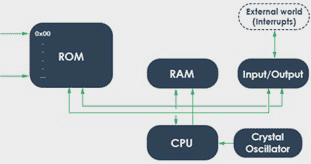A microcontroller is a small, low-cost computer-on-a-chip that is designed to perform a specific set of tasks. It is used in a variety of applications, including controlling machines, sensing and monitoring devices, and automated systems. A microcontroller typically consists of a central processing unit (CPU), memory, input/output (I/O) ports, and support for various peripherals such as timers, counters, and analog-to-digital converters. It is programmed using a specialized computer language and is capable of executing instructions stored in its memory. Some common examples of microcontrollers include the Arduino, Raspberry Pi, and the PIC microcontroller.
There are many different types of microcontrollers available in the market, with varying architectures, performance levels, and feature sets. Some common microcontroller architectures include:
- 8-bit microcontrollers: These microcontrollers have 8-bit CPUs and are typically used in low-end applications that do not require a lot of processing power. They are often less expensive than other types of microcontrollers and are commonly used in consumer products, such as appliances, toys, and other devices.
- 16-bit microcontrollers: These microcontrollers have 16-bit CPUs and are more powerful than 8-bit microcontrollers. They are commonly used in industrial and automotive applications, as well as in consumer products that require more processing power.
- 32-bit microcontrollers: These microcontrollers have 32-bit CPUs and are among the most powerful types of microcontrollers. They are often used in high-end applications that require a lot of processing power, such as in medical equipment, military systems, and other demanding applications.
Other types of microcontrollers include microprocessors, which are similar to microcontrollers but are typically used in larger, more complex systems; digital signal processors, which are specialized microcontrollers designed for processing digital signals; and field-programmable gate arrays, which are microcontrollers that can be programmed by the user.
How Microcontrollers Work?

The CPU is the brain of the microcontroller, responsible for executing instructions and controlling the other components of the microcontroller. It retrieves instructions from memory, decodes them, and then performs the operations specified by the instructions.
The memory stores the instructions and data that the CPU uses. Microcontrollers typically have two types of memory: read-only memory (ROM) and random access memory (RAM). ROM is used to store the program instructions, while RAM is used to store temporary data that the microcontroller needs to access quickly.
I/O ports allow the microcontroller to communicate with the outside world. These can include digital inputs and outputs, as well as analog inputs and outputs, depending on the specific capabilities of the microcontroller.
Peripherals are additional components that are built into the microcontroller to perform specialized tasks. These can include timers, counters, and analog-to-digital converters, among others.
To use a microcontroller, it must first be programmed using a specialized computer language. Once programmed, the microcontroller can execute the instructions stored in its memory and perform the tasks it was designed to do.
Microcontroller Applications
Microcontrollers are used in a wide variety of applications, including controlling machines, sensing and monitoring devices, and automated systems. Some common examples of microcontroller applications include:
- Industrial automation: Microcontrollers are commonly used to control industrial machines, such as robotic arms, conveyor belts, and other manufacturing equipment.
- Automotive: Microcontrollers are used in automobiles to control a variety of systems, including the engine, transmission, and brakes.
- Home appliances: Many household appliances, such as washing machines, refrigerators, and microwave ovens, contain microcontrollers to control their various functions.
- Consumer electronics: Microcontrollers are used in a wide range of consumer electronics, including smartphones, tablets, and other portable devices.
- Medical devices: Microcontrollers are used in a variety of medical devices, such as heart rate monitors, blood pressure monitors, and insulin pumps.
- Military systems: Microcontrollers are used in military systems, such as missiles, aircraft, and other defense systems.
- Environmental monitoring: Microcontrollers are used in sensors and other devices that monitor environmental conditions, such as temperature, humidity, and air quality.
- Robotics: Microcontrollers are used in robots to control their movements and perform various tasks.
- Internet of Things (IoT): Microcontrollers are used in IoT devices to collect and transmit data, and to control various functions.
Recommended: Microcontroller based Projects Ideas
Are Microcontrollers and Microprocessors the Same?
Microprocessors and microcontrollers are similar in that they are both integrated circuits that can be used to control electronic devices. However, they have some key differences.
In summary, a microprocessor is a general-purpose processor that can be used to perform a wide range of tasks, while a microcontroller is a specialized processor that is designed to control a specific device or perform a specific task.
We have a detailed comparison article: Difference between Microcontroller and Microprocessor
Microcontroller FAQs
Q1. What is the difference between a microcontroller and a microcomputer?
A microcomputer is a computer that is built around a microprocessor. It typically includes a processor, memory, and I/O peripherals, and can be programmed to perform a wide range of tasks. A microcontroller is similar to a microcomputer, but it is typically smaller and more specialized. It is designed to control a specific device or perform a specific task.
Q2. How do I get started with microcontroller programming?
To get started with microcontroller programming, you will need a microcontroller development board, a computer, and a programming toolchain. You can then write and upload programs to the microcontroller using a programming language of your choice. There are many resources available online that can help you learn more about microcontroller programming, including tutorials, documentation, and forums.
Q3: What programming languages can be used to program microcontrollers?
Microcontrollers can be programmed in a variety of languages, including C, C++, and assembly language.
Q4: How do microcontrollers store and execute programs?
A: Microcontrollers typically have onboard memory where programs can be stored and executed from. This can be a read-only memory (ROM), random access memory (RAM), or a combination of both. The type and amount of memory can vary depending on the specific microcontroller.
Q5: What are some common input/output (I/O) peripherals found on microcontrollers?
Some common I/O peripherals found on microcontrollers include:
- Digital input/output (I/O) pins: These can be used to read the state of buttons or switches or to control the state of LEDs or other devices.
- Analog-to-digital converters (ADCs): These can be used to convert analog signals (such as voltage levels) into digital values that can be read by the microcontroller.
- Timers: These can be used to generate timing signals or measure the duration of events.
- Serial communication interfaces (SCIs): These can be used to communicate with other devices over a serial link. Examples include UART, I2C, and SPI.
Q6: How do I choose the right microcontroller for my project?
When selecting a microcontroller for a project, you should consider the following factors:
- Processor type and speed: Consider the amount of processing power you will need and choose a microcontroller with a processor that meets your needs.
- Memory: Consider the amount of program and data storage you will need and choose a microcontroller with sufficient memory.
- I/O peripherals: Consider the types of I/O peripherals you will need and choose a microcontroller with the necessary peripherals.
- Package type: Consider the physical size and pin count of the microcontroller and choose a package that fits your needs.
- Cost: Consider your budget and choose a microcontroller that fits within your price range.









